
48 minute read
Faculty Research
IMS Members Respond to the COVID-19 Pandemic
Institute of Materials Science
Advertisement
As the reality of the COVID-19 pandemic became clear beginning in March of 2020, IMS was forced to shutter operations until safety standards could be established and implemented. Our staff began telecommuting to keep administrative tasks on target but laboratories remained closed pending those safety policies.
In the face of personal protective equipment (PPE) shortages for frontline healthcare workers and ventilators for coronavirus patients during the initial outbreak, IMS faculty members stepped up in creative ways. They worked to design custom-fitting masks, developed a prototype for an emergency-use ventilator, and produced hand sanitizer.
Dr. Jeffrey McCutcheon, in collaboration with the Fraunhöfer Center, led a team developing a prototype of an emergency ventilator that could be produced by Connecticut manufacturers to help ease the anticipated shortage of the devices as the novel coronavirus continued to spread across the state.
As a first step, the team built a prototype of the ventilator using a number of plastic parts. A second generation model was recently completed that is made out of aluminum.
McCutcheon’s hope was that the prototype used parts that would be easy to make by Connecticut manufacturers working in metal or machinery.
“It’s a clever, simple approach to produce a rapidly deployable emergency ventilator. If the health care professionals in the state or region see a shortage coming based on the models of ICU admittance, they could use these and not start from scratch.”
Dr. Cato Laurencin was first to point out the racial disparity in deaths from the virus. A review of public health data through the first few weeks of the COVID-19 pandemic found disproportionate infection and mortality rates in Connecticut’s minority populations, particularly among Blacks.
“We had the first peer-reviewed, published study that really stated that,” said Dr. Laurencin, CEO of the Connecticut Convergence Institute for Translation in Regenerative Engineering at UConn Health and lead author. “Also, we’re very proud that we pushed the state to move forward in terms of getting the data. Once they got the data and saw all the data, they realized that this was important to place on the state website for all to see.” Not long after the release of Dr. Laurencin’s findings, the nation began to wake up to the reality of the disparities.
Working with the Fraunhöfer USA Center for Energy Innovation, located in the Innovation Partnership Building at UConn’s Tech Park, chemical engineering doctoral student Noah Ferguson led a project that produced Husky Hand Sanitizer for distribution to local facilities and charities. The hand sanitizer was produced to World Health Organization (WHO) specifications. tom-fit mask frames and exoskeletons to give conventional masks the optimal protective qualities of N95 respirators.
“We use a combination of facial recognition software and 3D printing to create the exact dimensions and make the perfect size,” says Dr. Cato T. Laurencin, the Institute’s CEO. “It’s very difficult to make one-size fits all, and one size shouldn’t fit all.”
IMS is proud of our faculty, students, and staff. We salute them for rising to the challenges presented by the coronavirus pandemic.
The second generation prototype of the emergency ventilator.

Amir Seyedsalehi, a graduate research assistant in the Connecticut Convergence Institute for Translation in Regenerative Engineering, delivers custom-fit mask frames to the UConn Health intensive care unit, with nurse manager Patricia Hurley (left) and assistant nurse manager Crystall Coe (right). (Photo by Godwin Dzidotor)
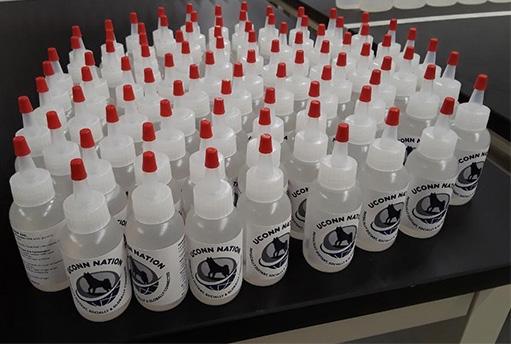
Construction Kicks Off on UConn’s Transformational New Science Quad, Future Home of IMS
UConn Today

An architect’s conception of what the Northwest Science Quad will look like from above once construction is completed. (Courtesy of Payette)
A transformational science complex that ties together UConn’s research expansion, academic vision, and culture of innovation is taking shape on the Storrs campus with the recent start of construction at the site.
The Northwest Science Quad, a complex that includes a 198,000-square-foot modern research facility and related amenities, is a cornerstone of the Next Generation Connecticut program adopted by the Connecticut General Assembly in 2013 to expand research and education in STEM fields (science, technology, engineering and math).
In addition to construction of a new building to be known as Science 1, the Northwest Science Quad project includes a Supplemental Utility Plant (SUP), a passive open space corridor running east to west through the property, an extension of the existing utility tunnel and associated parking.
If all remains on schedule, the research labs and other facilities inside the high-tech building would be ready to use by fall 2022.
“This project is a crucial step forward in the state’s investment in UConn as an engine for innovation and economic development in Connecticut,” says Carl W. Lejuez, UConn’s provost and executive vice president for academic affairs. “It also builds on one of President Katsouleas’s key priorities to boost entrepreneurship and research funding. I am excited to see these new facilities start to take shape and enhance the resources available to our faculty, staff, and students to advance Connecticut as a leading hub of STEM innovation.” teaching and core laboratories; a 240-seat active-learning room to engage students more dynamically than traditional lecture halls; along with faculty offices, public spaces including a new cafe, administrative support offices, and informal gathering spaces.
The building’s labs include traditional “wet” labs with chemicals, liquids, and other substances used for testing and analysis; along with “dry” labs where computer-generated models are created using computers for investigating a wide array of material science applications. It also includes a “clean room” designed to support specialized scientific research in a tightly controlled environment where contamination is minimized to protect the work by filtering airborne dust or other particulates from within the room.
“The plans for labs in Science 1 will bring to the forefront stateof-the-art facilities for interdisciplinary teaching, research, and outreach,” says Steven L. Suib, UConn Board of Trustees Distinguished Professor in Chemistry and Director of the Institute of Materials Science, the largest UConn academic enterprise that will move from the nearby Gant Science Complex to the new building.
“The new interactive learning room will be used by many on campus,” Suib says. “Several core lab facilities will also allow researchers to carry out new research, sensitive projects, and provide opportunities for large multi-disciplinary activities with considerable outreach to researchers from industry as well as government labs.”
IMS Welcomes New Faculty Members
Institute of Materials Science
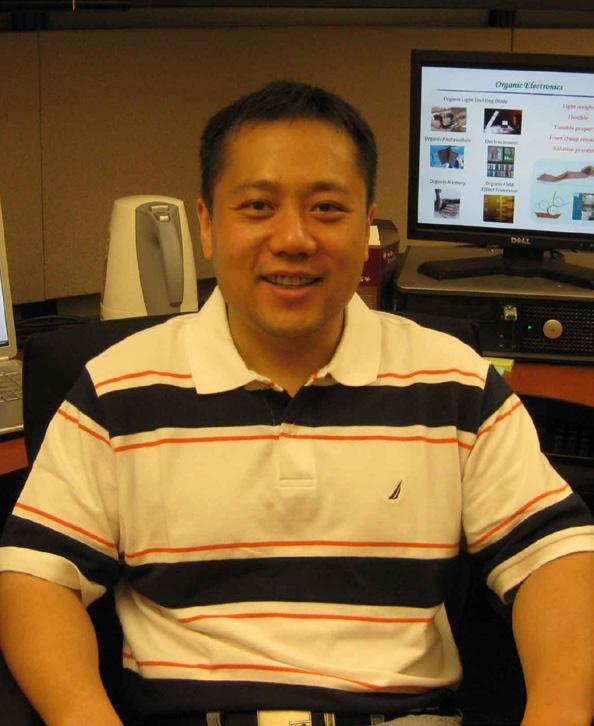
(l-r) Drs. Yang Qin, Xueju “Sophie” Wang, and Yi Zhang
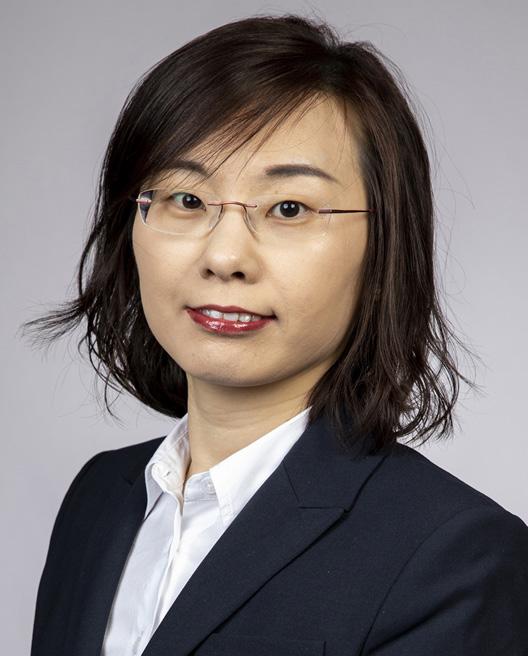

Dr. Yang Qin earned his Ph.D. from Rutgers University. His academic home is the Department of Chemical and Biomolecular Engineering. Dr. Qin’s research interests focus on design and synthesis of conjugated organic and polymeric materials, organic/inorganic hybrid materials, and their applications in energy and environment.
Dr. Sophie Wang holds a Ph.D. from Georgia Institute of Technology. Her research interests include soft/active/smart materials, nanomechanics and micromechanics of advanced materials, energy storage and conversion, flexible/stretchable/bio-integrated electronics, and in-situ/environmental operando experimental techniques. Dr. Wang is a faculty member of the Materials Science and Engineering Department.
Dr. Yi Zhang received his Ph.D. from Georgia Institute of Technology and is a member of UConn’s Department of Biomedical Engineering. His research interests include soft materials, bioelectronics and biosensors, colloids and interfacial science.
IMS Director’s Research Featured in The Economist
Institute of Materials Science
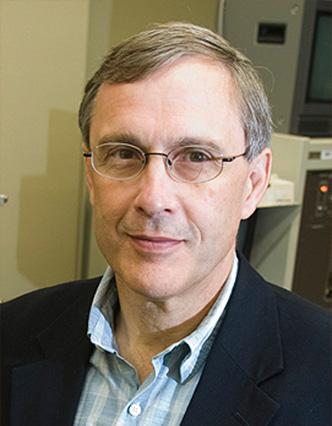
Imagine being able to create water from thin air. The ramifications for desert communities would be enormous. IMS Director Dr. Steven L. Suib has found a way to do just that by employing adsorption, a process by which water molecules are captured from air with less than 100% humidity and attached to the surface of a solid material allowing the water to be collected, absorbed, and stored. This research is the subject of an article in the January 11, 2020 edition of The Economist.
Dr. Suib’s research investigates the water sorption characteristic of birnessite (i.e. a layered structure manganese dioxide, or MnO2) from both thermodynamic and kinetic perspectives. According to the research, MnO2 is widely found in nature and possesses layered and tunnel structures that can adsorb between 4.8% and 16.2% of atmospheric water. Birnessite MnO2 is a better potential alternative material for water harvesting as it displays a layered structure with cations and water molecules intercalated. More importantly, MnO2 features solar absorptivity and can convert solar to thermal energy. The abundance of natural birnessite and the ability to create it artificially also make it a cheaper candidate for water harvesting applications.
Dr. Suib outlines his research in a paper, “Water Harvesting from the Atmosphere in Arid Areas with Manganese Dioxide”, published in Environmental Science and Technology Letters, a publication of the American Chemical Society in its December 19, 2019 issue.
Dr. Anson Ma Receives USDA Grant to Fund Research into 3D Printing
School of Engineering
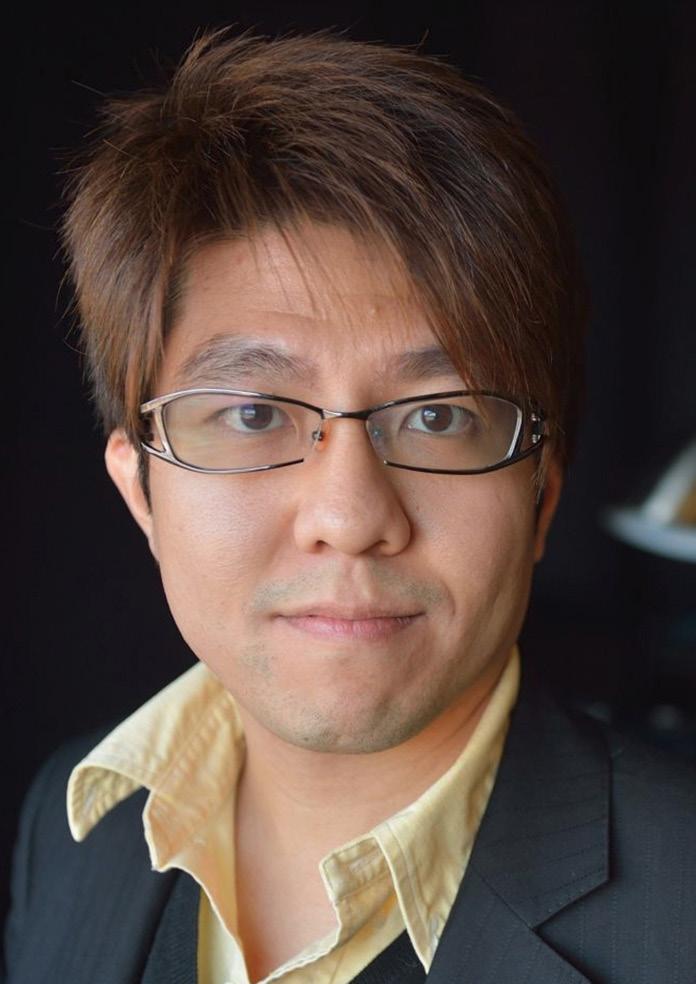
Dr. Anson Ma Armed with a four-year, $470,000 grant from USDA’s National Institute of Food and Agriculture, National Science Foundation (NSF) SHAP3D Center Site Director and Associate Professor of Chemical Engineering and Polymers Anson Ma—and his collaborator, Qian Yang, Assistant Professor of Computer Science and Engineering—are working on creating pulse-based food products with novel textures and customized nutritional profiles using machine learning and a specially designed 3D printer.
Pulses, which encompass all edible seeds in the legume family—including chickpeas, dry beans, lentils, and more—are seen as viable nutritional sources, as they are high in protein, complex carbohydrates, and low in calories and fat. During the next four years, the two researchers will work in conjunction with the U.S. Army Combat Capabilities Development Command (CCDC) Soldier Center (Natick, MA) to test their methods and results.
Ma and Yang will use UConn’s state-of-the-art pilot scale HuskyJet 3D printer housed at UConn’s Innovation Partnership Building. The versatile printer has a number of applications, which range from regular graphics on paper, to creating flexible electronics, medicinal tablets, and green parts for ceramics and metals. The printer was funded by UConn’s Academic Plan and has already been leveraged for a number of projects, including projects funded by the NSF SHAP3D center and a federally funded project from NextFlex – America’s Flexible Hybrid Electronics Manufacturing Innovation Institute – both of which UConn is a founding academic member.
CCDC-Soldier Center will provide expertise in food 3D printing and nutritional solutions. Food is unlike other material used in 3D printing, it is a uniquely complex non-linear material. CCDC-Soldier Center maintains 3D food prints with the capabilities and knowledge to characterize food matrices, conduct shelf-stability testing, evaluate sensory characteristics and perform nutritional and food microbiological analysis.
A number of societal benefits will be realized through this project. First, the ability to produce food that will meet an individual’s energy and nutrient needs, as well as flavor and texture preferences, and will help promote a healthier lifestyle. Second, by making the 3D printing technology more accessible, consumers will be able to experiment with different food forms at home, fostering creativity in the younger generations and changing their relationships with pulse-based products. Third, 3D food printers can function as standalone food production systems that could be used in disaster relief situations and austere environments. Lastly, the 3D food printing technology developed in this project can potentially be adapted for using a wide variety of sustainable feedstock materials.
Dr. Thomas Seery Serves Up a Special Course on Wine
Excerpted from a story from the Chronicle (of Eastern Connecticut)
It’s a big world out there when it comes to wine, the libation made from fruit of the vine.
Enter Thomas Seery, professor at the University of Connecticut, who teaches a class on “Understanding Wine Chemistry.” Seery lands in the right place at the right time when he makes his connections. He’s been teaching this class in Shanghai in the summers. Through a series of fortunate events, including passport control, meeting wives of professors and a group of scholars coming to UConn, Seery brings his interests in wine to the college community and beyond.
Throughout my Zoom interview, I heard words like tannins, retronasal, terpene and umami. Umami is a category of taste in food. I thought there were only four basic tastes, but there are more. It’s related to the flavor of glutamates.
The syllabus for a semester of Seery’s class included the physical chemistry of water/alcohol mixtures, understanding the fermentation process, the intricate and complex process of how fruit is grown (think how, where, amount of rain, sun and other elemental influences, how skins, seeds and stems contribute to the flavor, how yeasts act in the fermentation process, and so much more).
Is the taste astringent? Pungent? How about taste sensations? Does the tongue agree with the nose? How does the mouth feel? What is the bouquet/smell in the glass that is (only) a third full? These questions are addressed through the class.
And in case you were wondering, no, there is no tasting allowed in class since it is typically taught to undergraduates.
Dr. Thomas Seery
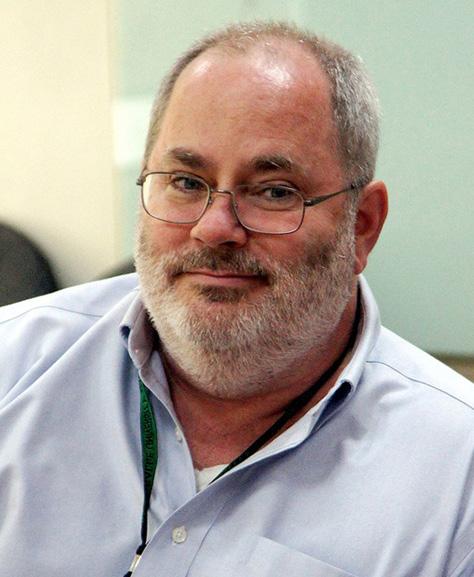
School of Engineering
Solar panel technology has seemingly boomed over the last 20 years, but when you dig into the numbers, only six percent of U.S. homes have panels installed on their roofs. The prevailing material used in solar cells is silicon, which is easy to manufacture and lasts decades, but the cost has remained high. University of Connecticut Materials Science and Engineering Department Head Bryan Huey and his postdoc Jingfeng Song have produced some compelling research reported in the journal Nature Communications that could lead to another lesser-known material to come to market at a fraction of the price.
The material, known as hybrid perovskites (HPs), can be manufactured into a thin film that is 200 times thinner than a conventional silicon cell but is just as efficient.
The biggest problem, says Huey, is their longevity does not yet match silicon cells, which are the prevailing material used in solar cells.
“The primary limitation thus far is that their lifetime cannot yet compete with modern silicon cells, especially because the perovskites are highly sensitive to humidity. From an engineering perspective, that ought to be solvable—we also needed to figure out how to protect silicon from humidity, and now those panels can be warrantied to still produce 80% of their installed efficiency after 25 years. Current targets are for 50 years,” Huey said.
“Imagine any other technology being able to keep working so well after so long. If the perovskite thin film’s cells can survive even to just 5-10 years, they’ll begin to displace silicon panels due to cost advantages.”
To help accelerate the technology to market, Huey and his team have spent the past several years developing a unique method of 3D mapping called tomographic atomic force microscopy (T-AFM). In this technique, which uses a super-hard tip to scrape away and map the layers of the material, researchers were able
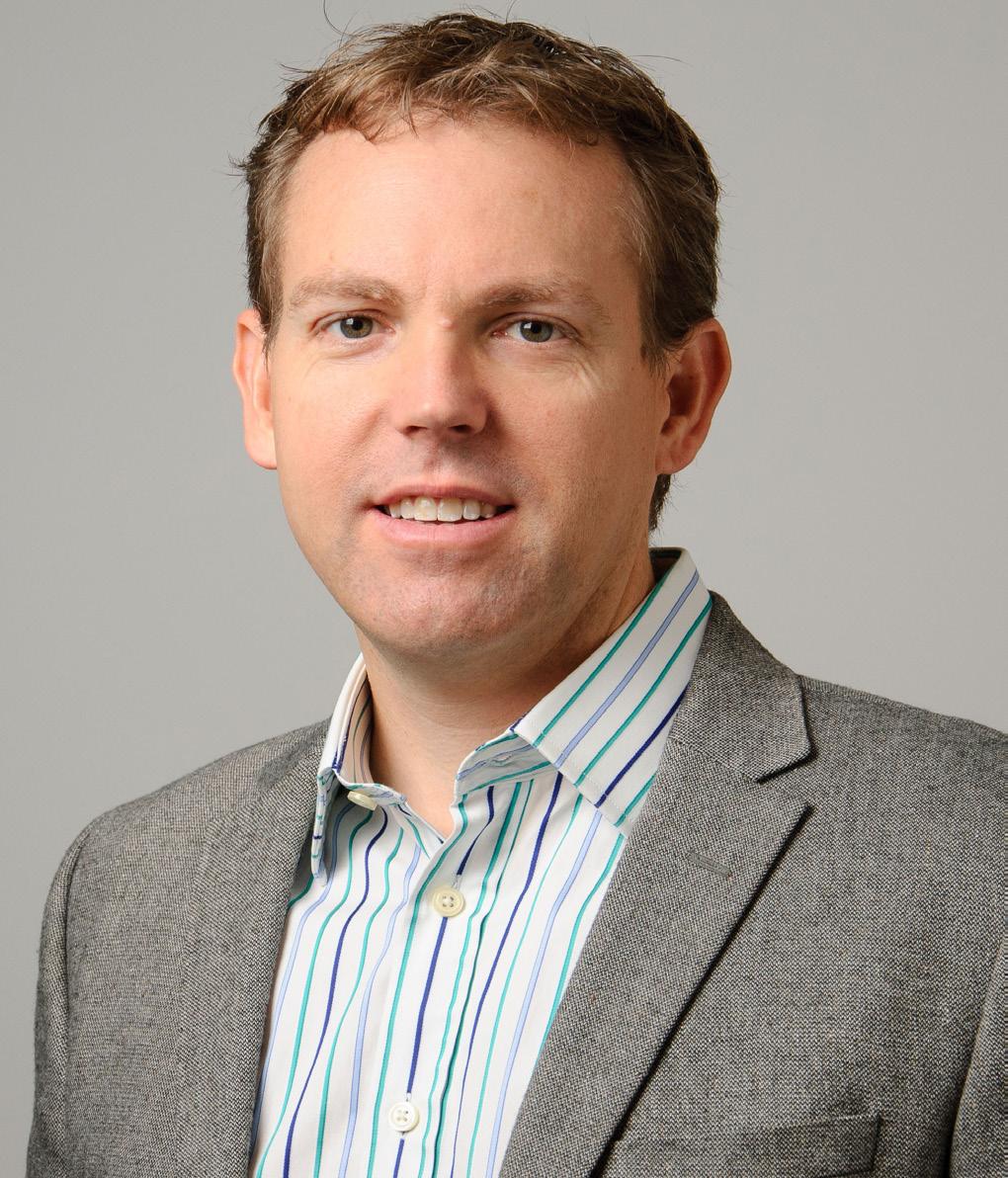
MSE Department Head, Dr. Bryan Huey

~Dr. Bryan Huey
to study the grain boundaries of the material, which had previously only been studied at the surface.
Huey said that studying the grain boundaries beneath the initial surface allows scientists to understand the functionality of energy generation more accurately.
“Surprisingly, we found a new type of grain boundary, which is almost indistinguishable from the other interfaces at the top surface. After digging into the HP thin film, these interfaces behave as if there is no grain boundary at all. They don’t provide any particular advantage compared to the adjacent grains, and indeed photo-generated electron and holes carriers are almost free to travel across them, instead of channeling along them. Without our T-AFM advances at UConn, thanks to an NSF grant along with support from the SOE and IMS, we’d all still be guessing at what lies beneath the surface.”
With this new research out, Huey hopes that scientists and manufacturers use this new knowledge to make HP technology more accessible to the consumer. Next he hopes to turn his attention to another piece of the puzzle—solar cell degradation.
Dr. Bryan Huey is Digging Into a More Cost-Effective Solar Technology
continued from previous page
“Specific to Hybrid Perovskites, our results may guide the efforts of film manufacturing, and device design, to either leverage or suppress the properties of the two distinct grain boundary types we’ve resolved. While we continue to develop the method and apply it to several fundamental problems in materials science, we are also specifically focusing on solar cell degradation, one of the greatest remaining roadblocks for HP films before they can really compete in the over $100 Billion solar panel market. Tune back again soon–we’re just beginning to scratch the surface.”
Professors Yuanyuan Zhou and Nitin Padture from the School of Engineering at Brown University, who collaborated with the team at UConn on this research, said that these findings can have a ripple effect on the industry.
“The tomographic AFM technique has the unique capability of revealing 3D buried microstructures at the nanoscale during perovskite device operation and degradation. This is extremely helpful for scientists and engineers to develop more robust hybrid perovskites devices in the future,” said Zhou and Padture.
Institute of Materials Science
Institute of Materials Science Assistant Professor, Dr. Yuanyuan Zhu, was awarded funding from the American Chemical Society Petroleum Research Fund for her project titled “Structural Basis for the Optimal Promotor Concentration and Distribution of Metal-Promoted Oxide Catalysts for Selective Oxidation of Alkane”.
Alkane dehydrogenation through catalytic selective oxidation has become increasingly important to modern petroleum refining and petroleum chemistry. In particular, the oxidative dehydrogenation (ODH) of light alkanes into olefins, which is essential to the production of high-value petrochemicals, such as ethylene, as well as the understanding of heterogeneous catalysis. According to Dr. Zhu’s proposal, “As the catalytic reaction is expected to convert a stable starting molecule into a less stable one at a relatively low temperature without combustion, high selectivity and stability, as well as activity, are desired in ODH catalysts.” However, Dr. Zhu states, “Conversion to high-value petrochemicals like ethylene poses a dual challenge for heterogeneous catalysis: the catalyst must be capable of activating the first C-H bond of highly saturated alkane while maintaining a high selectivity. Most oxidation catalysts developed so far can’t achieve both.” Dr. Zhu’s research looks to establish a clear structural picture of some of the best alkane oxidation catalysts. She proposes that this research will assist in solving that catalyst design problem.
Through the use of advanced analytical and in-situ environmental scanning transmission electron microscopy (STEM), Dr. Zhu looks to fill in the knowledge gaps between the commonly accepted “molecular” view and the lacking “structural” view of the prototypical alkane selective oxidation catalyst Nb-NiO. In particular, “we seek to establish a clear microstructural picture of the Nb-promoted NiO selective oxidation catalyst. Our work will emphasize the
Dr. Yuanyuan Zhu effective Nb-NiO phase stoichiometry and particle size, the Nb concentration variations in depth from the surface, the uniformity of Nb distributions, and the response of these characteristics under ethane ODH reaction conditions.” Dr. Zhu continues, “The main objective of the research will be to gain experimental insight into the structural properties of Nb-promoted NiO ODH catalysts and to explore fundamental correlations with physical properties and the catalytic performance in selective oxidation of light alkanes.” Dr. Zhu hypothesizes, “that the structural (including chemical) basis of these nanocatalysts at the particle, surface-facet, and atomic-scale levels plays an essential role in determining the nature and the abundance of selective active sites.”
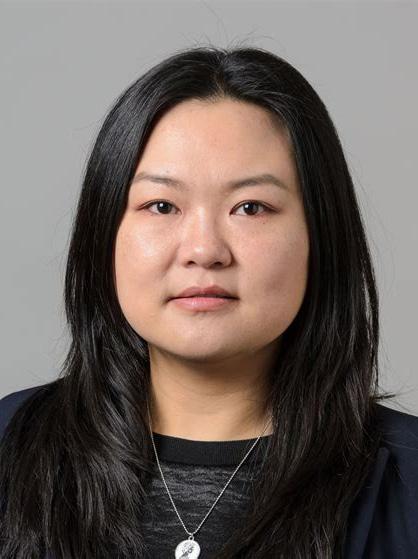
In addition to Dr. Zhu’s background researching the development of novel scanning transmission electron microscopy techniques, she is currently the Director of the DENSsolutions Center for IN-siTu/Operando Electron Microscopy (InToEM) at the University of Connecticut (UConn). She looks to utilize her experience, as well as the latest generation in-situ/operando (S) TEM NanoReactor at the UConn Tech Park, to pursue this project which will proposedly “establish a comprehensive understanding of the structural properties of a prototypical selective oxidation catalyst: Nb-promoted NiO nanoparticles.” From this research Dr. Zhu expects, “the fundamental insights we gain to provide guidance for the design of next-generation selective oxidation catalysts with enhanced olefin yield.”
~Dr. Yuanyuan Zhu
Dr. Xiuling Lu Invents Nanoparticle for Overcoming Leukemia Treatment Resistance
UConn Today
UConn associate professor of pharmaceutics Xiuling Lu, along with professor of chemistry Rajeswari M. Kasi, was part of a team that recently published a paper in Nature Cell Biology finding a commonly used chemotherapy drug may be repurposed as a treatment for resurgent or chemotherapy-resistant leukemia.
One of the largest problems with cancer treatment is the development of resistance to anticancer therapies. Few FDA-approved products directly target leukemia stem cells, which cause treatment-resistant relapses. The only known method to combat their presence is stem cell transplantation.
Leukemia, a cancer of the early blood-forming cells, or stem cells, presents unique treatment challenges due to its nature. The disease affects bone marrow, which produces blood cells. Most often, leukemia is a cancer of the white blood cells. The first step of treatment is to use chemotherapy to kill the cancerous white blood cells, but if the leukemia stem cells in the bone marrow persist, the cancer may relapse in a therapy-resistant form. Fifteen to 20% of child and up to two thirds of adult leukemia patients experience relapse. Adults who relapse face a less-than 30% five-year survival rate. For children the five-year survival rate after relapse is around two thirds. When relapse occurs, chemotherapy does not improve the prognosis for these patients.
There is a critical need for scientists to develop a therapy that can more effectively target chemotherapy-resistant cells.
There are two cellular pathways, Wnt–β-catenin and PI3K–Akt, which play a key role in stem cell regulation and tumor regenesis. Cooperative activation of the Wnt– β-catenin and PI3K–Akt pathways drives self-renewal of cells that results in leukemic transformation, giving rise to cancer relapse. Previous studies have worked on targeting elements of these pathways individually, which has had limited success and often results in the growth of chemo-resistant clones.
The researchers screened hundreds of drugs to find one that may inhibit this interaction. They identified a commonly used chemotherapy drug, doxorubicin as the most viable target. While this drug is highly toxic and usually used with caution in clinical settings, the team found when used in multiple, low doses, it disrupts the Wnt–β-catenin and PI3K–Akt pathways’ interaction, while potentially reducing toxicity. Lu’s lab contributed a nanoparticle which allowed the drug to be injected safely and released sustainably over time, a key to the experiment’s success. The nanoparticle encasing doxorubicin enables slow release of the drug to the bone marrow to reduce the Akt-activated β-catenin levels in chemo-resistant leukemic stem cells and reduce the tumorigenic activity. In low doses, doxorubicin stimulated the immune system while typical clinical doses are immunosuppressive, inhibiting healthy immune cells.
Lu is the CEO of Nami Therapeutics, a startup which designs nanoparticles for drug delivery in a variety of clinical contexts including cancer treatment and vaccine delivery.
Because of its rate of drug release, Lu’s patented nanoparticle was more effective than both a solution of the pure drug and a liposomal doxorubicin, the only commercially available version of a nanoparticle carrying doxorubicin.
“It’s exciting that the whole research team identified this new mechanism to effectively inhibit leukemia stem cells,” Lu says. “We are happy to see that our proprietary nanoparticle delivery system has such potential to help patients.”
By using low, but more sustained, doses of this drug, leukemia-initiating activity of cancerous stem cells was effectively inhibited.
Dr. Xiuling Lu

~Dr. Xiuling Lu
The researchers demonstrated clinical relevance by transplanting patient leukemic cells into mice and observing that lowdose doxorubicin’s ability to disrupt these cells. Patient sample transplants with therapy-resistant leukemia stem cells rapidly developed leukemia. But the low-dose doxorubicin nanoparticle treatment improved survival by reducing the presence of leukemia stem cells.
Lu says the next steps for this research is to further validate the now-patented method and nanoparticle and eventually bring it into clinical usage. Lu and her collaborator, Rajeswari Kasi, also have two pending patents on copolymer-nanoparticles for drug delivery and methods for treating chemo-resistant cancer-initiating cells.
UConn, Army Research Lab Collaborate on New Portable, Renewable Energy Technology
UConn Today

Dr. S. Pamir Alpay UConn’s Associate Dean for Research and Industrial Partnerships, S. Pamir Alpay, and Yomery Espinal ’18 Ph.D. (ENG) have published a paper on a novel portable pyroelectric technology in Cell Reports Physical Science with support from the Army Research Laboratory.
Pyroelectric energy research is focused on how to generate energy from heat that would otherwise be wasted in a catalytic chemical reaction.
When pyroelectric materials are heated, their polarization changes, leading to an electron flow that generates energy. These materials are commonly used in household devices like motion sensor lights, which detect body heat to determine when someone is near.
Anytime there is a catalytic reaction, heat is generated. These devices harness that heat and use it as energy. For example, a combustion engine in a car produces heat that, with this kind of technology, could be used to power the electrical functions of the car that otherwise rely on battery power.
The Army Research Lab (ARL) is particularly interested in this technology because it can provide more power with less weight, which is important for soldiers carrying heavy bags.
While scientists have been experimenting with pyroelectric power for decades, the technology proposed in this paper is completely novel.
“Something like that doesn’t exist,” Alpay says. “It would give you the opportunity to recover some things that just go to waste.”
The technology proposed in this publication is portable and has an extended lifetime. It uses on-chip combustion of methanol, a high-energy fuel, to harness energy from the reaction. The pyroelectric material converts waste heat from the reaction to usable power. Vapor of a high-energy fuel, in this case methanol, is combusted on a thin, 440 nanometer film on platinized silicon wafers. The device converts the heat from this reaction into pyroelectric power.
Nanostructured iridium oxide is the top electrode and combustion catalyst. Iridium is a dense, corrosion and heat-resistant metal making it an excellent candidate for this application. Iridium oxide is first activated at temperatures as low as 105 degrees Celsius and fully catalyzes methanol to carbon dioxide at 120 degrees Celsius.
This is an advantage compared to platinum-based catalysts, which do not achieve full conversion until 150 degrees Celsius. This means less heat must be applied to the device for it to be fully effective.
This on-chip combustion technology has a 90% combustion efficiency rate.
This technology would be significantly more powerful than lithium-ion batteries, the common rechargeable batteries used in electronics. The energy density of methanol is 22 times greater than a lithium-ion battery.
While this study only provided researchers with a preliminary version of this technology, it can have far-reaching applications.
Pyroelectric power is a clean alternative to fossil fuels and nuclear energy, which still constitute more than 80% of the United States’s power. Thus, this technology has broad energy applications on large and small scales.
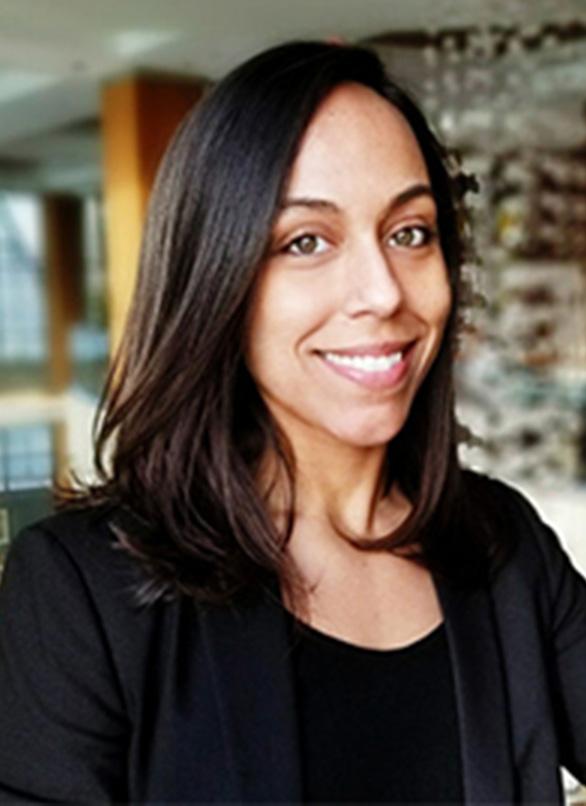
Brendan Hanrahan, Ph.D., a staff materials engineer at ARL, led this effort on ARL’s side of the partnership. Hanrahan operated as a critical hinge to bring the ARL and UConn researchers together for this project.
Espinal earned her Ph.D. at UConn and was awarded the Bridge to the Doctorate Fellowship in 2013, which supports members of underrepresented groups in STEM. She began working at the Army Research Lab with Hanrahan during her time in the program and spent two years there. Immediately after graduation, she was offered a position with the Defense Advanced Research Projects Agency (DARPA).
Over the past few years, UConn and ARL have fostered a productive partnership that will likely continue for years to come. “The key to our successful collaboration is that we play off each other’s strengths,” says Dr. Hanrahan,. “Without one another [Alpay’s] theories would remain theories and we’re just shooting in the dark. So that’s why it’s such a great partnership.”
MSE Professor’s Research is More Than What Meets the Eye Materials Science and Engineering Department
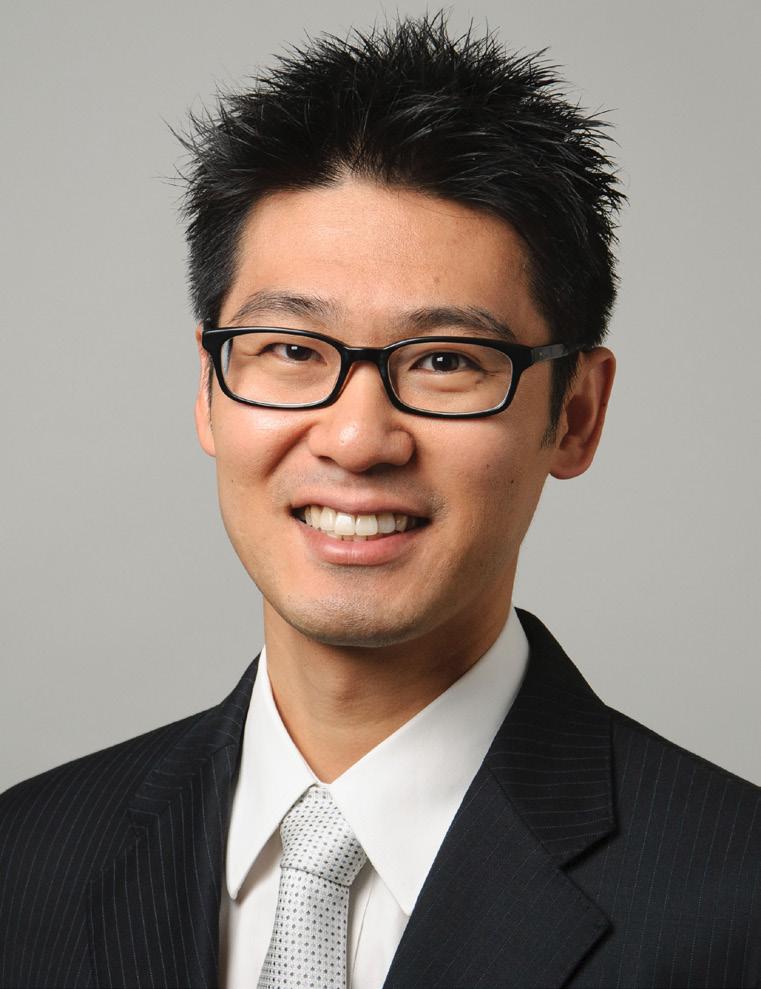
Dr. Seok-Woo Lee Many of the materials that UConn MSE Assistant Professor Seok-Woo Lee works with in his research are invisible to the naked eye. In order to even see them, an electron microscope is required. Some samples are more than 100 times thinner than a human hair. Despite this, the nanomaterials that Lee researches are crucial to producing mechanically robust devices and structures.
According to Lee, creating resilient small materials is important for smaller machines.
“In order to develop a mechanically reliable robot or machine at the nano-/micro-meter scale, we need to know how to create a strong and tough ‘small’ material,” Lee said. His research group is working on understanding how characteristics of materials can influence mechanical behaviors of substances including metals, ceramics, intermetallic compounds, and polymers.
One such way to control mechanical behavior is reducing the size of materials. As a material’s size decreases from macro to nano-/micro-meter scales, it usually becomes much stronger and tougher. However, this can change as temperatures become more extreme. Part of Lee’s research involves exposing micromaterials such as metals to very cold temperatures, where they become brittle and fracture easily. Lee is attempting to find a way to avoid this.
It is important to understand how materials may respond in extremely cold environments for applications such as the vacuum of space. One example is called a cryogenic shape memory material, which can recover its original shape even after being largely deformed. The process of recovering its shape by expanding or contracting can be used to create mechanical motion.
“This long-range motion can turn on an electrical switch for a cold, dormant satellite in deep space once it meets a heat source such as a star. Also, this material can be used to move a mechanical component to control a robotic arm or telescope lens that is used under cold environments such as the shadow area of the moon,” Lee said.
Although Lee is dedicated to his research, he mainly sees himself as a teacher.
“Teaching is very important to me because I have always believed that I am basically a teacher. Once a student receives a good lecture, they can remember what they learn for a longer time,” Lee said. Lee has received multiple awards for his teaching, including the UConn Mentorship Excellence Award in 2019 and UConn MSE Teaching Excellence of the year in 2017 and 2018. Lee is proud of being recognized for educating.
Lee has both undergraduate and graduate students, and over time, he has learned that they both require different approaches. According to him, the major difference is independence when it comes to performing research.
“A graduate student can design and perform experiments by themselves. However, I usually assign a simple and relatively straightforward research topic to undergraduate students because they are very busy due to their classes. I usually give step-by-step instructions to an undergraduate student, then they can learn the details of the research even without much prior experience,” said Lee. The graduate students Lee works with handle the microscopic material that he researches and are able to “pull and push a sample with an extremely precise control of force,” Lee said. An electron microscope has to be used in order to see these samples, as they are too small to be visible in a regular optical microscope.
MSE Professor’s Research is More Than What Meets the Eye continued from previous page
According to Lee, it is fun for him to work with the three undergraduates and five graduate students who are part of his research group. He feels his MSE students should be especially proud of their major.
“I want to tell our MSE students that their decision to study MSE is a great choice. More and more I see that technological breakthroughs require the development of new advanced materials. Creating high-performance engineering devices such as micro-processors, airplanes, satellites, etc. requires sophisticated materials design and processing. Because of this, studying MSE becomes more important in overcoming our technological limits. So, I really think they should be proud to be MSE majors,” Lee said.
In addition to his work with students, Lee also collaborates with other faculty members on research. One such project is a cold spray project for the US Army, which he is working on with MSE professors Avinash Dongare, Mark Aindow, and Harold Brody. Lee enjoys these collaborations, which helped influence his decision to come to UConn.
“I chose UConn because of great people here. All of the faculty and students I met during the interview were very nice and friendly to me. I always believe that working with wonderful people is very important, and I thought (and still think) that those people are here at UConn,” said Lee.
Lee discovered materials science when he was in high school. He always wanted to combine his love of physics and chemistry with “making something useful,” which was fulfilled by materials science and engineering.
“I found that materials science and engineering is the best program because I can do both science and engineering! Also, I always wondered how matter was formed after the beginning of the universe, and I thought that it would be wonderful if I could design and create a special matter under my own control,” Lee said.
This interest followed Lee to his current career, and he is optimistic about his students also being a part of the MSE field.
“They can use this knowledge of materials to improve our world,” Lee said.
IMS Associate Director Hebert Leads Successful Research Collaboration Between UConn MSE and Industry
Materials Science and Engineering Department
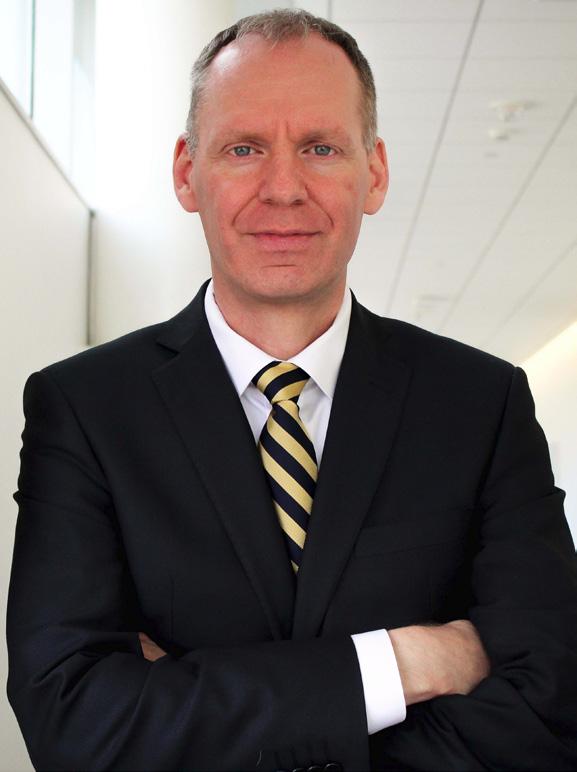
IMS Associate Director, Dr. Rainer Hebert MSE professor Rainer Hebert recently led a study in collaboration with the Collins Aerospace Center for Advanced Materials at the UConn Tech Park. Collaborating partners also included Pratt & Whitney, Schlumberger Reservoir Completions Technology Center, and UTC Additive Manufacturing Center of Excellence. The study, entitled “Novel Al-X alloys with improved hardness,” centers on high-strength aluminum-based materials for use in 3-D printing, an additive manufacturing process.
This research is of strong interest to the aerospace industry because materials such as aluminum that are light and strong are used to manufacture small aircraft parts with complex geometries that are difficult to produce with traditional manufacturing.
“Working with Collins and Pratt & Whitney helped us remain focused on the end goal of aerospace applications, and their input is invaluable for bridging the gap from fundamental research to applications,” Hebert said.
The Collins Aerospace Center, established in 2016 and directed by MSE professor Pamir Alpay, is the result of continuing collaboration between UConn and Collins Aerospace, one of the world’s largest suppliers of technologically advanced aerospace and defense products. The center offers funding for studies that focus on areas related to materials development and characterization. It also provides an opportunity for firsthand interactions with an industrial partner whose technologies are used in advanced aerospace and defense applications.
This study is one of several related to 3-D printing that UConn MSE has conducted with the help of the Collins Center. Hebert expects that more collaborations will occur.
Institute of Materials Science
After 19 years as a faculty member of the Institute of Materials Science Polymer Program and Chemical and Biomolecular Engineering Department, Professor Richard Parnas retired in August 2020 from the University of Connecticut.
Dr. Parnas summarized his career choices over the past 30 years stating, “My career was shaped by my desire to create environmentally responsible materials and energy solutions”. His words and resume both reflect his passion to helping the environment. Since completing his bachelor’s degree, Dr. Parnas has worked for big industry, government, and academia on a variety of projects relating to environmental issues.
After completing his bachelor’s degree in chemical engineering at MIT, Dr. Parnas joined Exxon Research & Engineering in Florham Park, NJ. There he worked on his first environmentally friendly project, coal gasification. He helped engineer a proposed plant for Europe that would convert coal into methane at the rate of 30,000 tons per day. Although the project never came to fruition, this was the first of many environmental projects. Exxon’s abandonment of the project led Dr. Parnas to return to school. He completed his master’s degree, and later his Ph.D., at U.C.L.A.
Upon completion of graduate school, he spent 10 years in the polymers division at the National Institute of Standards and Technology (NIST), first as a chemical engineer, then as a composites group leader. His research was based around manufacturing technology. The main focus was to create new lighter weight materials for cars in an effort to increase gas mileage and reduce CO2 production. While at NIST, Dr. Parnas met Prof. Anthony DiBenedetto of the IMS Polymer Program while hosting an international meeting on composites processing, initiating his association with and eventual move to join IMS.
In 2001, Dr. Parnas was hired by IMS as a faculty member of the Polymer Program. His initial research interest was polymer composites and renewable polymers created from plant protein. Starting in 2005, Dr. Parnas became involved with a number of aspects of the world of biofuels. This changed his research direction and ultimately his career path. He ran the annual Biofuels and Sustainable Energy Symposiums at UConn from 2005 to 2010. These events were key to opening communications between state representatives, local industry professionals, and scientists from the university. It enabled discussions regarding the technical components, policies, and financial aspects of energy. The conference included as many as 300 participants, including
Dr. Richard Parnas 25 state and federal representatives such as Rosa DeLauro and John Larson.

In 2007, an undergraduate asked Dr. Parnas for help with a biofuels project. This simple question led Dr. Parnas down a path to three patents, the creation of a business, and eventually a new career. The original project led the student to a Ph.D. and a faculty position at Oregon State University.
A collaboration with IMS Director Steven Suib and other University faculty landed a 1.2 million dollar Department of Energy grant to support biofuels research at UConn. This was a stepping stone to Dr. Parnas’s research. The funding increased the research staff, enabling publications and further supporting his reputation in the field. He was elected to the Connecticut Academy of Science & Engineering in 2013. After seven patents, he was also inducted into the UConn chapter of the National Academy of Inventors in 2019. During this time, he developed a novel transesterification reactor for the efficient conversion of triglycerides to biodiesel. The reactor was patent worthy and a key component to his future company. In 2018, after 11 years of research and three U.S. patents, Dr. Parnas created REA Resource Recovery Systems, LLC. The company processes brown grease, sourced from wastewater treatment plants, into biodiesel. The end result is less waste and reduced carbon emissions. This benefits the company, local government, and our mother earth.
In addition to education and research, Dr. Parnas spent five years as the faculty director for UConn’s EcoHouse, one of the learning communities on the Storrs campus. Participating students dedicate their time to a variety of environmental issues, such as sustainable energy, farming, and government policies. At the UConn Spring Valley Student Farm, students grow food for dining services at the Storrs campus. They learn about both farming and selling their products. A team of engineering students also worked on solar energy, both photovoltaic and thermal, to support the farm. As faculty director, Dr. Parnas was able to help students bring their specific set of skills and interests to the learning community.
Dr. Parnas’s lasting contributions to the University are tremendous, setting a tone for engaging students and inspiring interest in the ways that modern science interfaces with our ecological footprint. Helping to educate hundreds of students and introducing dozens to the wonderful world of scientific research, many UConn undergraduate engineers and chemists received their first experience in a scientific setting under the advisement of Dr. Parnas. This experience helped pave their paths to a career or graduate school.
Quantum Effect Triggers Unusual Material Expansion
UConn Today
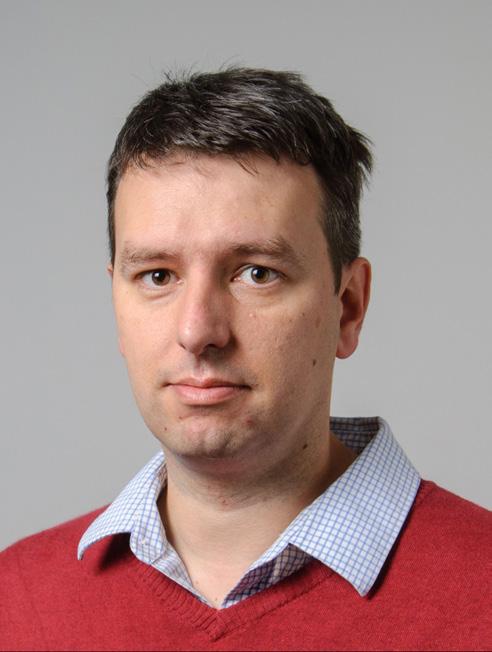
Dr. Jason Hancock You know how you leave space in a water bottle before you pop it in the freezer—to accommodate the fact that water expands as it freezes? Most metal parts in airplanes face the more common opposite problem. At high altitudes (and low temperatures) they shrink. To keep such shrinkage from causing major disasters, engineers make airplanes out of composites or alloys, mixing materials that have opposite expansion properties to balance one another out.
New research conducted in part at UConn and the U.S. Department of Energy’s Brookhaven National Laboratory may bring a whole new class of chemical elements into this materials science balancing act.
As described in a paper just published on March 26 in Physical Review Letters, scientists used x-rays at Brookhaven’s National Synchrotron Light Source II (NSLS-II)—a U.S. Department of Energy Office of Science user facility—and two other synchrotron research facilities to explore an unusual metal that expands dramatically at low temperature. The experiments on samarium sulfide doped with some impurities revealed details about the material’s atomic-level structure and the electron-based origins of its “negative thermal expansion.”
This work opens avenues for designing new materials where the degree of expansion can be precisely tuned by tweaking the chemical recipe. It also suggests a few related materials that could be explored for metal-mixing applications. “In practical applications, whether an airplane or an electronic device, you want to make alloys of materials with these opposite properties—things that expand on one side and shrink on the other when they cool down, so in total it stays the same,” explained Daniel Mazzone, the paper’s lead author and a postdoctoral fellow at NSLS-II and Brookhaven Lab’s Condensed Matter Physics and Materials Science Department.
But materials that mimic water’s expansion when chilled are few and far between. And while the expansion of freezing water is well understood, the dramatic expansion of samarium sulfide had never been explained.
This samarium-based compound (specifically samarium sulfide with some yttrium atoms taking the place of a few samarium atoms) reveals competing electronic phases (somewhat analogous to the solid, liquid, and gaseous phases of water). De-
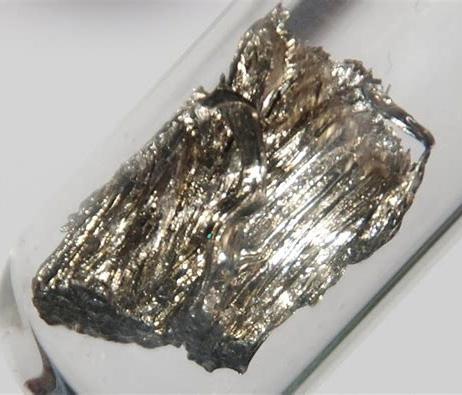
~Dr. Jason Hancock
pending on external conditions such as temperature and pressure, electrons in the material can do different things. In some cases, the material is a gold-colored metal through which electrons can move freely—a conductor. In other conditions, it’s a black-colored semiconductor, allowing only some electrons to flow.
The golden metallic state is the one that expands dramatically when chilled, making it an extremely unusual metal. Mazzone and his colleagues, including UConn physics professor Jason Hancock, an expert in materials with negative thermal expansion (that is, materials that expand when cold and shrink when warm), turned to x-rays and theoretical descriptions of the electrons’ behavior to figure out why.
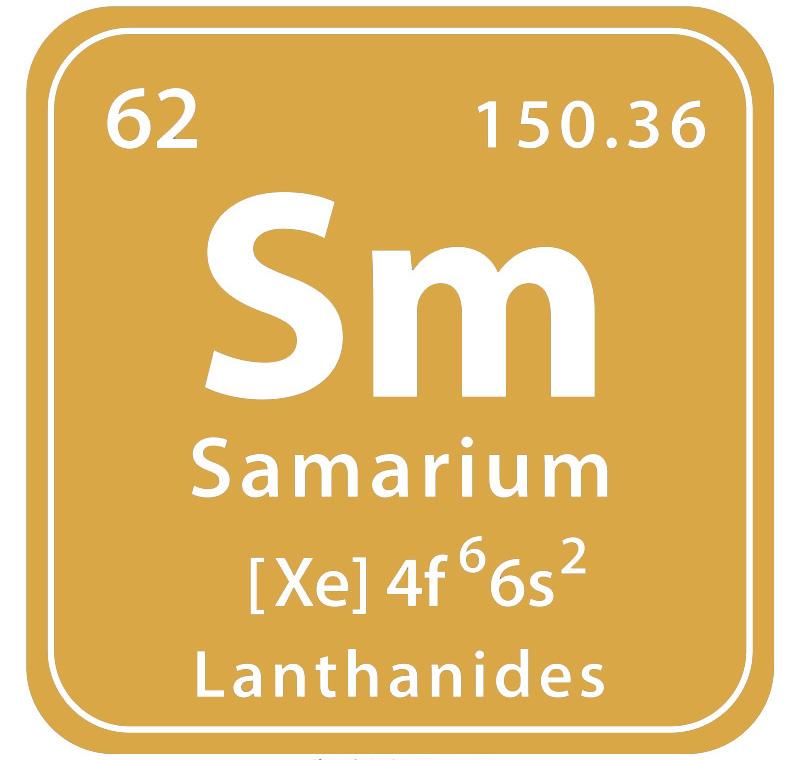
The element samarium
At NSLS-II’s Pair Distribution Function (PDF) beamline, the scientists conducted diffraction experiments. They placed samples of their samarium metal in the beam of NSLS-II’s x-rays and measured how the x-rays bounced off atoms making up the material’s crystal structure.
The team also used x-rays at the SOLEIL synchrotron in France and Spring-8 synchrotron in Japan to take a detailed look at what electrons were doing in the material at different stages of the temperature-induced transition.
“These ‘x-ray absorption spectroscopy’ experiments can track whether electrons are moving into or out of the outermost ‘shell’ of electrons around the samarium atoms,” explained co-corresponding author Ignace Jarrige, physicist at NSLS-II.
If you think back to one of the basics of chemistry, you might remember that atoms with unfilled outer shells tend to be the most reactive. Samarium’s outer shell is just under half full.
The electron-tracking x-ray experiments revealed that electrons flowing through the samarium-sulfide metal were moving into that outer shell around each samarium atom. As each atom’s electron cloud grew to accommodate the extra electrons, the entire material expanded.
But the scientists still had to explain the behavior based on physics theories. With the help of Maxim Dzero, a professor at Kent State University, they were able to explain the effect with the so-called Kondo effect, named after physicist Jun Kondo.
The basic idea behind the Kondo effect is that electrons will interact with magnetic impurities in a material, aligning their own spins in the opposite direction of the larger magnetic particle to “screen out,” or cancel, its magnetism. netic impurity pointing in a certain direction. “And because you have a metal, you also find free electrons that can approach and cancel out these little magnetic moments,” Dzero said.
“This work connects negative thermal expansion to the Kondo effect, potentially guiding new materials discovery efforts in the context of moment screening in rare-earth systems,” said UConn’s Hancock.
It’s unusual for the Kondo effect to cause electrons to fill the outermost shell. More often, they go the other way—leaving the shell—which arises from a delicate energy balance dictated by basic quantum mechanical rules. These rules suggest that compounds incorporating two other elements in the same region of the periodic table—the breakout section that contains the “transition elements”—might also attract extra electrons.
“In most of these elements, because of the way the outer shell
fills up following the rules of quantum mechanics, it is more energetically favorable for electrons to move out of the shell, but for a couple of these materials, the electrons can move in,” Jarrige said. In addition to samarium (Sm), the other two are thulium (Tm) and ytterbium (Yb).
It would be worth exploring compounds containing these other elements as additional possible ingredients for creating materials that expand upon cooling, Jarrige noted.
Finally, the scientists noted that the extent of the negative thermal expansion in samarium sulfide can be tuned by varying the concentration of impurities.
“This tunability makes this material very valuable for engineering expansion-balanced alloys,” Mazzone said.
“The application of highly developed many-body theory modeling was an important part of the work to identify the connection between the magnetic state of this material and its volume expansion,” said Hancock. “This collaboration between Kent State, UConn, Brookhaven Lab, partner synchrotrons, and synthesis groups in Japan could potentially guide new materials discovery efforts that make use of the unusual properties of these rare-earth materials.”
Dr. Thanh Nguyen’s Group Develops New Technique to Heal Broken Bones
UConn Today
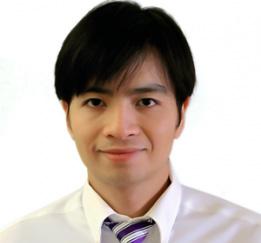
Healing broken bones could get easier with a device that provides both a scaffold for the bone to grow on and electrical stimulation to urge it forward, University of Connecticut engineers reported on June 27, 2020 in the Journal of Nano Energy.
Although minor bone breaks usually heal on their own, large fractures with shattered or missing chunks of bone are more difficult to repair. Applying a tiny electrical field to the site of the fracture to mimic the body’s natural electrical field helps the cells regenerate. But the medical devices that do this are usually bulky, rely on electrical wires or toxic batteries, require invasive removal surgery, and can’t do much for serious injuries.
Now, a group of biomedical engineers from UConn have developed a scaffold of non-toxic polymer that also generates a controllable electrical field to encourage bone growth. The scaffold helps the body bridge large fractures. Although many scientists are exploring the use of scaffolding to encourage bone growth, pairing it with electrical stimulation is new.
The team demonstrated the device in mice with skull fractures.
The electrical voltage the scaffold generates is very small, just a few millivolts. And uniquely for this type of device, the voltage is generated via remotely-controlled ultrasound. The ultrasound vibrates the polymer scaffolding, which then creates an electrical field (materials that create electricity from vibration, or vice versa, are called piezoelectric). To help heal a thigh fracture, for example, the polymer scaffold can be implanted across the broken bone. Later, the person with the broken bone can wave the ultrasound wand over their own thigh themselves. No need for batteries, and no need for invasive removal surgery once the bone is healed. “The electrical field relates to the natural signal generated by your body at the injury location. We can sustain that voltage, on demand and reversible, for however long is needed using ultrasound,” says UConn biomedical engineer Thanh Nguyen. The piezoelectric polymer Nguyen and his colleagues use to build the scaffold is called poly(L-lactic acid), or PLLA. In addition to being non-toxic and piezoelectric, PLLA gradually dissolves in the body over time, disappearing as the new bone grows.
“The electric field created by the piezoelectric PLLA scaffold seems to attract bone cells to the site of the fracture, and promote stem cells to evolve into bone cells. This technology can possibly be combined with other factors to facilitate regeneration of other tissues, like cartilage, muscles, or nerves,” says Ritopa Das, a graduate student in Nguyen group and the first author of the published paper.
Currently, Nguyen and his colleagues are working to make the polymer more favorable to bone growth, so that it heals a large fracture more quickly. They are also trying to understand why electrical fields encourage bone growth at all. Bone itself is somewhat piezoelectric, generating a surface charge when the bone is stressed by everyday life activities. That surface charge encourages more bone to grow. But scientists don’t know whether it’s because it helps cells stick to the surface of the bone, or whether it makes the cells themselves more active.
“Once we understand the mechanism, we can devise a better way to improve the material and the whole approach of tissue stimulation,” Nguyen says.

Healing broken bones could get easier, thanks to research being done by UConn biomedical engineers (Getty Images).
Institute of Materials Science
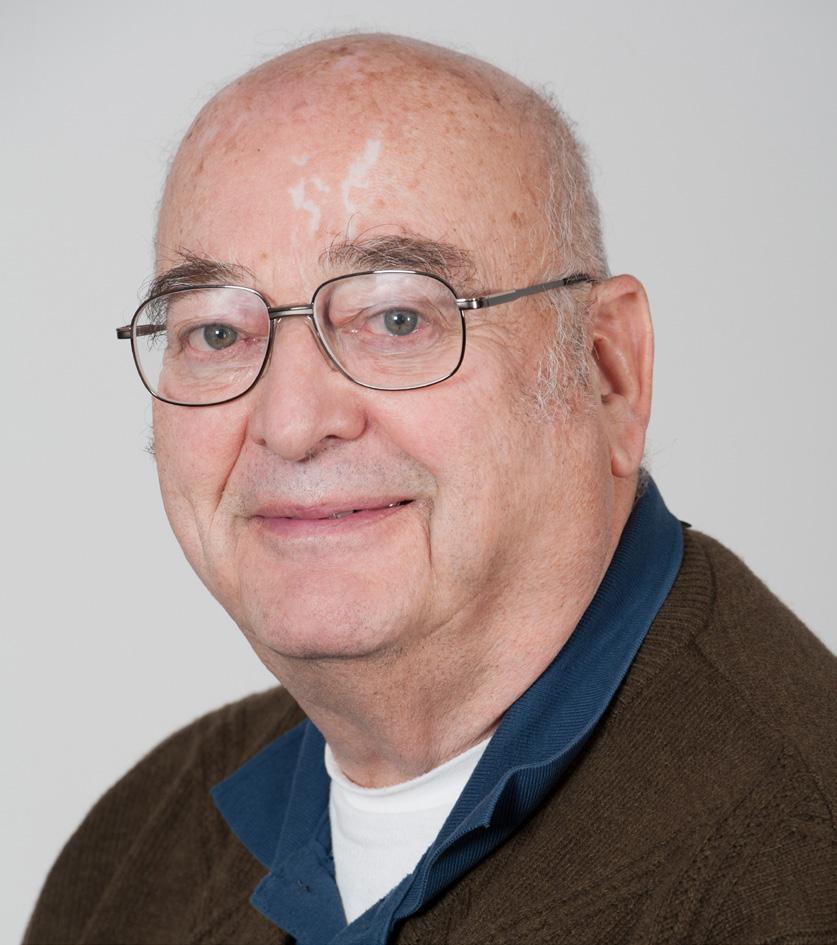
Dr. Harris L. Marcus, former IMS Director Former IMS Director, Dr. Harris Marcus, passed away on January 14, 2021. Dr. Marcus earned his B.S. from Purdue University and a Ph.D. from Northwestern University. He served as Professor of Mechanical Engineering and Materials Science and Engineering at the University of Texas at Austin from 1975 to 1995 after a career in industry that included positions at Texas Instruments and Rockwell Science Center. He joined the UConn faculty in 1995 as Director of IMS.
During his tenure as Director of IMS, Dr. Marcus dramatically increased the infrastructure for research within IMS through the acquisition of major instrumentation for both soft and hard materials, and by rigorously recruiting excellent faculty members and graduate students to the University. His efforts led to significantly greater partnerships with industry and federal/state agencies for extramural support for research and development.
Dr. Marcus’s career was marked by numerous awards for excellence including the Von Karman Memorial Special Award for Outstanding Contributions to Aerospace and Structural Materials Technology in Past Decade, the Purdue University Distinguished Engineering Alumnus Award, Northwestern University Alumni Association Award of Merit, and induction in the Connecticut Academy of Science and Engineering. He had well over 300 peer-reviewed publications.
Current IMS Director, Dr. Steven L. Suib, said in his remembrance of Dr. Marcus, “Dr. Harris Marcus was Director of IMS for 18 years. He was always interested in research and enthusiastically discussed his ideas with everyone. He made people laugh and was fun to be around. We will miss him dearly.”
Dr. Marcus was preceded in death by his wife, Leona Marcus. He is survived by his son, Leland Marcus, his daughter, Dr. M’Risa Mendelsohn, his son-in-law Michael Mendelsohn, and his granddaughter, Samantha Mendelsohn.
In Memoriam: Dr. John E. Morral
Excerpted from Ohio State University, Department of Materials Science and Engineering
John Eric Morral, age 81, passed away unexpectedly on Monday, December 21, 2020. He was born in Kokomo, Indiana on August 3, 1939 to Rolf and Lillie Morral. He was also preceded in death by his sister Sandra Pinkham. John received his undergraduate and Master of Science degrees in Metallurgical Engineering from The Ohio State University, graduating in 1965. He completed his doctoral work at the Massachusetts Institute of Technology, receiving his Ph.D. in 1969. He joined the University of Connecticut in 1971 and became a full professor and chair of his department. Within a week of his retirement in 2003, he was recruited to be chair of OSU’s Material Science and Engineering Department. He retired from OSU in 2012, becoming an emeritus professor. John continued his professional work as Editor-in-Chief of the Journal of Phase Equilibria and Diffusion. John was the recipient of numerous awards for his many scientific contributions. He was named a Fellow of ASM International in 1995; named a Distinguished Alumnus of the OSU College of Engineering in 1995; elected a member of the Connecticut Academy of Science and Engineering in 2003; honored with a TMS Honorary Symposium in 2004; received an American Competitiveness and Innovation Fellow Award, NSF Division of Materials Research in 2009; received a Distinguished Scientist/Engineer Award, TMS Division of Materials Processing and Manufacturing in 2012; and awarded the J. Willard Gibbs Phase Equilibria Award in 2017.

Dr. John E. Morral
John will be deeply missed by his loving wife of 42 years Dorothy “Dot” Morral; children Peter (Bronwin) Morral, Ingrid Morral (Patrick Quesenberry), Kenneth Cammarato, and Cheryl (Jerry) Wolters; grandchildren Natalie and William Morral; siblings Frank (Linda) Morral, Ann (Matthew) Sandor, Harriet (Jim) Perkins; brother-in-law Galen Pinkham; and numerous nieces and nephews.
In Memoriam: Dr. James Galligan
Institute of Materials Science

Dr. James Galligan Dr. James Galligan, Professor Emeritus of Metallurgy (currently Materials Science and Engineering) passed away on September 7, 2020, at the age of 89.
He was born in Far Rockaway, NY, to the late John A. and Teresa (Martin) Galligan and raised in Woodmere, NY. He earned his undergraduate degree from Brooklyn Polytechnic Institute, his master’s degree from the University of Illinois, and his Ph.D. in Metallurgical Engineering from the University of California at Berkley. He was a Professor at Columbia University and the University of Connecticut, where he retired after 30 years. Over his career, he mentored numerous students earning their Ph.D. degrees. Dr. Galligan was awarded the prestigious Humboldt Research Award in 1986 from the Humboldt Foundation, Bohn, Germany, in recognition of his research and teaching accomplishments.
Dr. Theodoulos Kattamis, Professor of Materials Science and Engineering, was a close, personal friend of Dr. Galligan. He recounted how Dr. Galligan was instrumental in the transition of the Metallurgy Department to, eventually, the Materials Science and Engineering Department in keeping with changing trends.
“A few years after joining the Department he thought it was time for us to follow the majority of Metallurgy Departments that changed their names to Materials Science and Engineering. Unfortunately, it took many years to change the name to Metallurgy and Materials Science and only in 2002 the name Materials Science and Engineering was finally adopted,” Dr. Kattamis recalled.
Speaking further of the keen foresight of Dr. Galligan, Dr. Kattamis noted, “From the late seventies he understood that the viability of the then graduate Department (Metallurgy) would be guaranteed only if an undergraduate program were added, too. He started advocating for this change, which was much later embraced by Owen Devereux, and it eventually became a reality. Finally, he promoted the Engineering/Physics double major which was instituted in the mid 1990’s.”
Dr. Galligan’s family remembers that his love of learning did not stop in the classroom. He enjoyed reading, sometimes juggling multiple books at a time. He loved the New York Times, and solved the crossword puzzles every day, never using anything but an ink pen. He was a supporter of the arts, especially the Manhattan Theatre Club, and an avid gardener. They also remember him as a staunch, liberal Democrat who was active during the civil rights movements of the 1960s and throughout his life.




